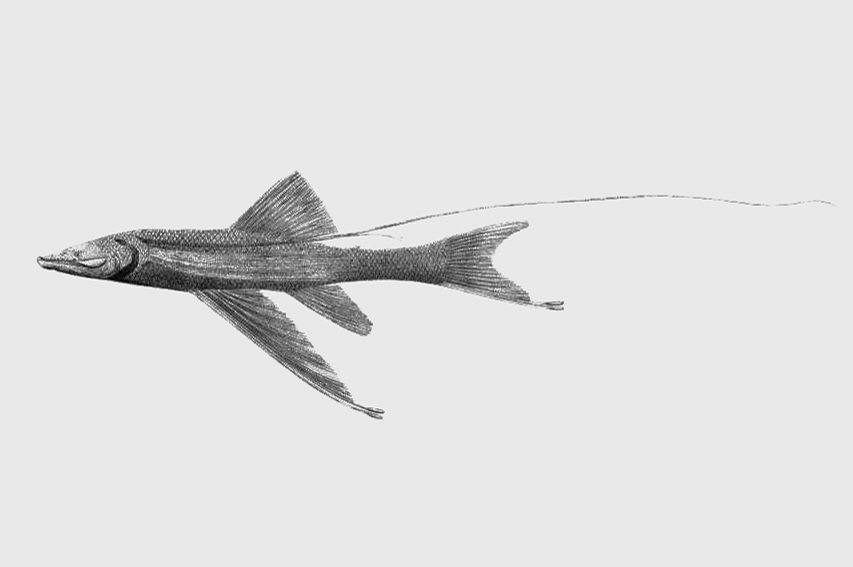Bighanded Feelerfish, Bathypterois filiferus Gilchrist 1906

Illustration of the holotype of the Bighanded Feelerfish, Bathypterois filiferus, from off South Africa. Source: After Fig. 48, in Gilchrist (1906) Marine Investigations in South Africa 4 / Biodiversity Heritage Library. License: CC by Attribution
Summary:
A large dark spiderfish with extremely elongate produced pectoral-fin rays, the first two pelvic-fin rays equally strengthened, elongate, and usually not fused, thick adherent scales, and no subcaudal notch.
Cite this page as:
Bray, D.J. 2022, Bathypterois filiferus in Fishes of Australia, accessed 27 Jun 2025, https://fishesofaustralia.net.au/Home/species/5365
Bighanded Feelerfish, Bathypterois filiferus Gilchrist 1906
More Info
|
Distribution |
Great Australian Bight, South Australia, the Lord Howe Rise north of Lord Howe Island, and Norfolk Ridge, north of Norfolk Island in the Tasman Sea. Elsewhere the species occurs in the Atlantic: Brazil, South Africa. |
|
Features |
Dorsal fin 14; Anal fin 9-10; Pectoral rays 13-16 visible externally, 18-22 total, long rays in lower part 11-14; Pelvic fin 8; Caudal fin (dorsal + ventral) v-vii 10+9 iv-v; Gill rakers (anterior arch) 12-1 3+1+28-30; Branchiostegal rays 12; Lateral-line scales 57-60; Dentary lateral-line pores 7, small to moderate; Vertebrae (incl. urostyle) 52-55, dorsal-fin origin over vertebra 21-25, anal-fin origin under vertebra 30-34. Scales thick, adherent; ventral procurrent rays not modified to form a subcaudal notch; first and second pelvic-fin rays equally strengthened, produced, not fused (usually). |
|
Biology |
Spiderfishes (family Ipnopidae) are simultaneous hermaphrodites. Individuals have an ovotestis containing functional male and female reproductive tissue. |
|
Remarks |
Individuals prop tripod-like on their long pelvic and caudal fin rays, raising their bodies off the seafloor. They face into the current, extending their long sensory pectoral fins forward to detect the movement of zooplankton such as small crustaceans that drift by in the current. Underwater ROV images have shown the trails made when these fishes 'walk' over the seafloor on their pelvic fins and lower tail fin lobe. |
|
Etymology |
The specific name filiferus is from the Latin filum (= thread) and fero (= to bear, to be carrying) in reference the extremely elongate upper pectoral-fin rays that are considerably longer that the body of this species. |
|
Species Citation |
Bathypterois filiferus Gilchrist 1906, Marine Investigations in South Africa 4: 166, pl. 48. Type locality: Off Cape Point, South Africa, depth 600-100 fathoms. |
|
Author |
Bray, D.J. 2022 |
|
Resources |
Bighanded Feelerfish, Bathypterois filiferus Gilchrist 1906
References
Gilchrist, J.D.F. 1906. Descriptions of fifteen new South African fishes with notes on other species. Marine Investigations in South Africa 4: 143-171 pls 37-51 See ref at BHL
Lörz, A.N., Berkenbusch, K., Nodder, S., Ahyong, S., Bowden, D., McMillan, P., Gordon, D., Mills, S. & Mackay, K. 2012. A review of deep-sea benthic biodiversity associated with trench, canyon and abyssal habitats below 1500 m depth in New Zealand waters. New Zealand Aquatic Environment and Biodiversity Report No 92. 133 pp
Moore, J. & Polanco Fernandez, A. 2019. Bathypterois filiferus. The IUCN Red List of Threatened Species 2019: e.T123323295A123323670. https://dx.doi.org/10.2305/IUCN.UK.2019-2.RLTS.T123323295A123323670.en. Downloaded on 28 October 2020.
Sulak, K.J. 1977. The systematics and biology of Bathypterois (Pisces, Chlorophthalmidae) with a revised classification of benthic myctophiform fishes. Galathea Report 14: 49-108, Pls. 1-7. See ref online (pdf)
Sulak, K. 1986. Family No. 76: Chlorophthalmidae. pp. 261-265 in Smith, M.M. & Heemstra, P.C. (eds). Smith's Sea Fishes. Johannesburg : Macmillan South Africa xx + 1047 pp. 144 pls. See ref at BHL
Sulak, K.J. & Shcherbachev, Yu.N. 1988. A new species of tripodfish, Bathypterois (Bathycygnus) andriashevi (Chlorophthalmidae), from the western South Pacific Ocean. Copeia 1988(3): 653-659. https://doi.org/10.2307/1445383

